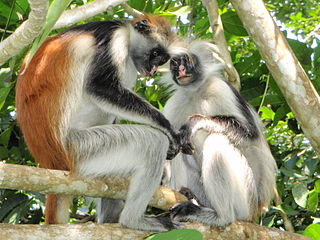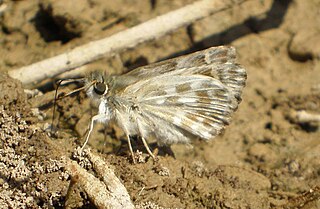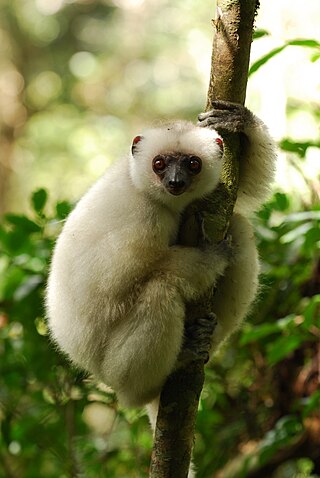
Mountain coatis are two species of procyonid mammals from the genus Nasuella. Unlike the larger coatis from the genus Nasua, mountain coatis only weigh 1.0–1.5 kilograms (2.2–3.3 lb) and are endemic to the north Andean highlands in South America.

The order Notostraca, containing the single family Triopsidae, is a group of crustaceans known as tadpole shrimp or shield shrimp. The two genera, Triops and Lepidurus, are considered living fossils, with similar forms having existed since the end of the Devonian, around 360 million years ago. They have a broad, flat carapace, which conceals the head and bears a single pair of compound eyes. The abdomen is long, appears to be segmented and bears numerous pairs of flattened legs. The telson is flanked by a pair of long, thin caudal rami. Phenotypic plasticity within taxa makes species-level identification difficult, and is further compounded by variation in the mode of reproduction. Notostracans are omnivores living on the bottom of temporary pools and shallow lakes.

Triops is a genus of small crustaceans in the order Notostraca. The long-lasting resting eggs of several species of Triops are commonly sold in kits as pets. The animals hatch upon contact with fresh water. Most adult-stage Triops have a life expectancy of up to 90 days and can tolerate a pH range of 6 to 10. In nature, they often inhabit temporary pools.

Red colobuses are Old World monkeys of the genus Piliocolobus. It was formerly considered a subgenus within the genus Procolobus, which is now restricted to the olive colobus. They are closely related to the black-and-white colobus monkeys, and some species are often found in groups with the blue monkey. The western red colobus is frequently hunted by the common chimpanzee.

Lepidurus is a genus of small crustaceans in the order Notostraca. It is the larger of the two extant genera of the tadpole shrimps, the other being Triops. They are commonly found in vernal pools and survive dry periods with the help of long lasting resting eggs.

Triops granarius is a species of tadpole shrimp with a broad distribution from Africa and the Middle East to China and Japan, although there are indications that it, as presently defined, is a species complex. They have elongated bodies and large flaps. Triops granarius can be kept as pets in home aquaria. Their life expectancy is up to 90 days, and in that time they can grow more than 6 cm in length.

Muschampia baeticus, the southern marbled skipper, is a butterfly of the family Hesperiidae. It is found in North Africa, south-western Europe, Italy and Anatolia up to Afghanistan.

The World's 25 Most Endangered Primates is a list of highly endangered primate species selected and published by the International Union for Conservation of Nature (IUCN) Species Survival Commission (SSC) Primate Specialist Group (PSG), the International Primatological Society (IPS), Global Wildlife Conservation (GWC), and Bristol Zoological Society (BZS). The IUCN/SSC PSG worked with Conservation International (CI) to start the list in 2000, but in 2002, during the 19th Congress of the International Primatological Society, primatologists reviewed and debated the list, resulting in the 2002–2004 revision and the endorsement of the IPS. The publication was a joint project between the three conservation organizations until the 2012–2014 list when BZS was added as a publisher. The 2018–2020 list was the first time Conservation International was not among the publishers, replaced instead by GWC. The list has been revised every two years following the biannual Congress of the IPS. Starting with the 2004–2006 report, the title changed to "Primates in Peril: The World's 25 Most Endangered Primates". That same year, the list began to provide information about each species, including their conservation status and the threats they face in the wild. The species text is written in collaboration with experts from the field, with 60 people contributing to the 2006–2008 report and 85 people contributing to the 2008–2010 report. The 2004–2006 and 2006–2008 reports were published in the IUCN/SSC PSG journal Primate Conservation,, since then they have been published as independent publications.
Triops vincentinus is a species of freshwater crustacean tadpole shrimps.
Triops mauritanicus is a species of tadpole shrimp, found in Southern Spain and Morocco. This species of Triops can grow to 4 to 6 cm and can be expected to live for 90-120 days on average. This species can be usually found in arid areas and are sometimes sold in kits.
Triops gadensis is a European species of arthropod in the genus Triops, that belongs to the family of Triopsidae. Triops gadensis are omnivores and in the wild they mainly eat algae and protozoa; larger Triops gadensis that are about 1–2 cm (0.39–0.79 in) in length feed on detritus, plant fibres and tiny crustaceans such as ostracods or copepods. However when food sources are scarce they will cannibalize each other. These crustaceans swim by drag swim power, which is a method of swimming that all Triops use.

Triops emeritensis is a species of branchiopod within the family Triopsidae. The species is endemic to the Iberian Peninsula in Extremadura, only being recorded from two ponds near La Albuera, Badajoz. The species has been assessed as 'Critically endangered' by the IUCN Red List, as despite its temperory ponds being in a protected area it still faces potential threats such as nearby agriculture and water extraction, along with habitat fragmentation from human infrastructure and natural barriers.









